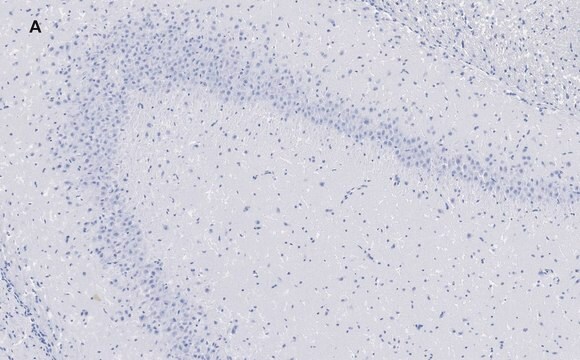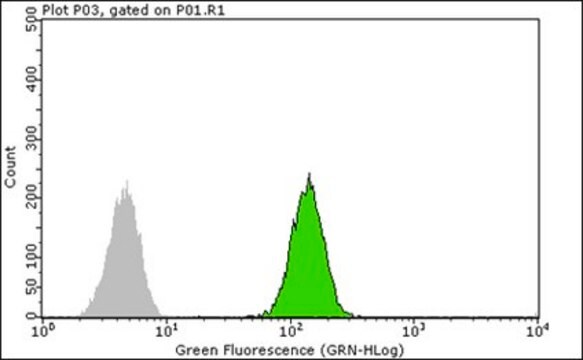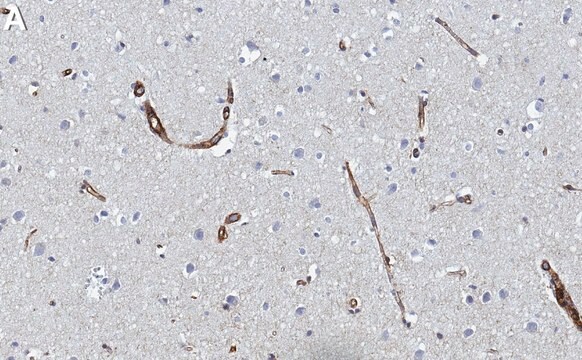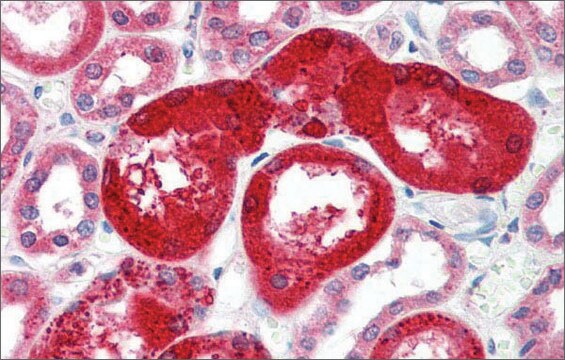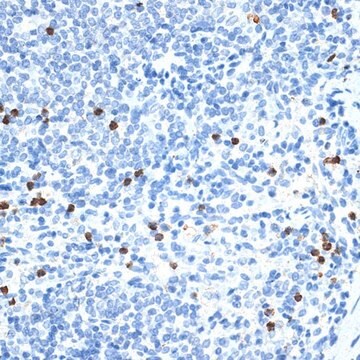推荐产品
生物源
mouse
品質等級
抗體表格
purified antibody
抗體產品種類
primary antibodies
無性繁殖
3E3, monoclonal
物種活性
human
技術
ELISA: suitable
immunocytochemistry: suitable
immunohistochemistry: suitable
inhibition assay: suitable
western blot: suitable
同型
IgG1κ
NCBI登錄號
UniProt登錄號
運輸包裝
wet ice
目標翻譯後修改
unmodified
基因資訊
human ... FN1(2335)
一般說明
Fibronectin (FN), or in earlier literature also known as Cold-insoluble globulin (CIG), and is encoded by the gene named FN1/FN is an extracellular matrix protein. Fibronectins bind cell surfaces and various compounds including collagen, fibrin, heparin, DNA, and actin. Fibronectins are involved in cell adhesion, cell motility, opsonization, wound healing, and maintenance of cell shape. Fibronectin also plays an important role in bone development and bone structure formation. Additionally, when fibronectin binds the protein anastellin it forms a multiprotein complex termed superfibronectin that has been shown to inhibit tumor growth, angiogenesis and metastasis. Fibronectin protein can be found extracellularly as well as intracellularly. There are multiple isoforms produced by alternative splicing. Plasma fibronectin (a soluble dimeric form) is secreted by hepatocytes into the blood. Cellular fibronectin (dimeric or cross-linked multimeric forms), are made by fibroblasts, epithelial and other cell types, and is deposited as fibrils in the extracellular matrix.
免疫原
Epitope: This antibody recognizes the cell attachment fragment of Fibronectin.
Purified human Fibronectin, which contains the Cell Attachment Fragment, from amnion liquid.
應用
Research Category
Cell Structure
Cell Structure
Research Sub Category
ECM Proteins
ECM Proteins
This Anti-Fibronectin (Cell Attachment Fragment) Antibody, clone 3E3, Ascites & Azide Free is validated for use in western blotting, IHC, ELISA, ICC & inhibition for the detection of Fibronectin.
Western Blotting Analysis: 0.5 µg/mL of this antibody detected Fibronectin (Cell Attachment Fragment) in 10 µg of U-251 cell lysate.
Immunohistochemistry Analysis: A 1:500 dilution from a representative lot detected Fibronectin (Cell Attachment Fragment) in human placenta and liver tissues.
ELISA Analysis: A representative lot detected the conformation of Fibronectin adsorbed onto self-assembled monolayers (SAMs) of alkanethiols over a range of Fibroectin surface densities (Kesolowsky, B. G., et al. (2003). J Biomed Mater Res A. 66(2):247-259.).
Immuncytochemistry Analysis: A representative lot detected Fibronectin (Cell Attachment Fragment) in Extracellular matrix deposited by HUVECs (Orecchia, A., et al. (2003). J Cell Sci. 116(Pt 17):3479-3489.).
Inhibition Analysis: A representative lot blocked cell-adhesive epitopes of Fibronectin (Cell Attachment Fragment) (Miller, D. C., et al. (2005). J Biomed Mater Res A. 73(4):476-84.).
Inhibition Analysis: A representative lot blocked RGD-dependent cell adhesion (Tsang, T. M., et al. (2012). J Biol Chem. 287(20):16759-16767.).
Inhibition Analysis: A representative lot inhibited the cell-adhesive epitopes of Fibronectin (Miller, D. C., et al. (2005). J Biomed Mater Res. 73(4):476-484.)
Immunohistochemistry Analysis: A 1:500 dilution from a representative lot detected Fibronectin (Cell Attachment Fragment) in human placenta and liver tissues.
ELISA Analysis: A representative lot detected the conformation of Fibronectin adsorbed onto self-assembled monolayers (SAMs) of alkanethiols over a range of Fibroectin surface densities (Kesolowsky, B. G., et al. (2003). J Biomed Mater Res A. 66(2):247-259.).
Immuncytochemistry Analysis: A representative lot detected Fibronectin (Cell Attachment Fragment) in Extracellular matrix deposited by HUVECs (Orecchia, A., et al. (2003). J Cell Sci. 116(Pt 17):3479-3489.).
Inhibition Analysis: A representative lot blocked cell-adhesive epitopes of Fibronectin (Cell Attachment Fragment) (Miller, D. C., et al. (2005). J Biomed Mater Res A. 73(4):476-84.).
Inhibition Analysis: A representative lot blocked RGD-dependent cell adhesion (Tsang, T. M., et al. (2012). J Biol Chem. 287(20):16759-16767.).
Inhibition Analysis: A representative lot inhibited the cell-adhesive epitopes of Fibronectin (Miller, D. C., et al. (2005). J Biomed Mater Res. 73(4):476-484.)
品質
Evaluated by Western Blotting in HepG2 cell lysate.
Western Blotting Analysis: 0.5 µg/mL of this antibody detected Fibronectin (Cell Attachment Fragment) in 10 µg of HepG2 cell lysate.
Western Blotting Analysis: 0.5 µg/mL of this antibody detected Fibronectin (Cell Attachment Fragment) in 10 µg of HepG2 cell lysate.
標靶描述
~260 kDa observed
外觀
Protein G Purified
0.01M Phosphate Buffer containing no preservative, pH 7.1
Format: Purified
儲存和穩定性
Stable for 1 year at -20°C from date of receipt.
Handling Recommendations: Upon receipt and prior to removing the cap, centrifuge the vial and gently mix the solution. Aliquot into microcentrifuge tubes and store at -20°C. Avoid repeated freeze/thaw cycles, which may damage IgG and affect product performance.
Handling Recommendations: Upon receipt and prior to removing the cap, centrifuge the vial and gently mix the solution. Aliquot into microcentrifuge tubes and store at -20°C. Avoid repeated freeze/thaw cycles, which may damage IgG and affect product performance.
其他說明
Concentration: Please refer to the Certificate of Analysis for the lot-specific concentration.
免責聲明
Unless otherwise stated in our catalog or other company documentation accompanying the product(s), our products are intended for research use only and are not to be used for any other purpose, which includes but is not limited to, unauthorized commercial uses, in vitro diagnostic uses, ex vivo or in vivo therapeutic uses or any type of consumption or application to humans or animals.
未找到合适的产品?
试试我们的产品选型工具.
儲存類別代碼
12 - Non Combustible Liquids
水污染物質分類(WGK)
WGK 1
閃點(°F)
Not applicable
閃點(°C)
Not applicable
Synthetic peptide with cell attachment activity of fibronectin.
Pierschbacher, M, et al.
Proceedings of the National Academy of Sciences of the USA, 80, 1224-1227 (1983)
Detachment of cells from culture substrate by soluble fibronectin peptides.
Hayman, E G, et al.
The Journal of cell biology, 100, 1948-1954 (1985)
M D Pierschbacher et al.
The Journal of biological chemistry, 257(16), 9593-9597 (1982-08-25)
The complete amino acid sequence of the cell attachment domain of human plasma fibronectin (Pierschbacher, M. D., Hayman, E. G., and Ruoslahti, E. (1981) Cell 26, 259-267) has been determined by automated sequential degradation of a peptic fragment comprising this
Arg-Gly-Asp: a versatile cell recognition signal.
Ruoslahti, E and Pierschbacher, M D
Cell, 44, 517-518 (1986)
Christian Woltersdorf et al.
Matrix biology : journal of the International Society for Matrix Biology, 63, 91-105 (2017-02-14)
Interactions of cells with supramolecular aggregates of the extracellular matrix (ECM) are mediated, in part, by cell surface receptors of the integrin family. These are important molecular components of cell surface-suprastructures regulating cellular activities in general. A subfamily of β1-integrins
我们的科学家团队拥有各种研究领域经验,包括生命科学、材料科学、化学合成、色谱、分析及许多其他领域.
联系技术服务部门